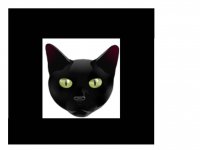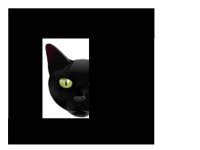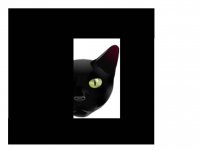Try this experiment. Cut a two-inch wide by three-inch tall rectangle out of a piece of paper and tape it on your bathroom mirror. When you look into the rectangle you --assuming you are a black cat-- will see something like this:

Take a few mental notes on what you see, like
(1) your left ear is aligned with the left edge of the opening,
(2) your right ear is aligned with the right edge of the opening, and
(3) your nose is in the middle
(4) The window--which is not square-- appears square
Now close your left eye. You will see something like this:

a few more mental notes:
(1) left ear still aligned with left edge
(2) nose no longer in the middle but rather close to the right edge
(3) right ear is out of view
Now close your right eye. You will see something like this:

a few more mental notes:
(1) right ear still aligned with right edge
(2) nose no longer in the middle but rather close to the left edge
(3) left ear is out of view
When we look with both eyes open and can see the whole face, what eye is providing the sense of alignment? Clearly for the parts of the face that we can only see with the left eye, the left eye is providing the alignment. What about the parts of the cat's face that we can see with both eyes but are close to the left-eye-only parts? The left eye must be playing a big role there because we don't see a discontinuous change.
I think how we meld these images together to produce a combined both-eyes image is complicated and probably very individual. The details probably depend on what our mind thinks is important in the views in front of us.
For instance when we are down on the shot, and only one of our eyes can see the pocket, many of us are probably not going the throw out that information. If you're down low on a thin cut to the left, there are head positions where the left eye can see the edge of the object ball and the right eye can't. In those head positions, I think we would nearly all get our sense of alignment from the left eye, even those of us who consider ourselves right-eye-dominant.
This stuff is very very complicated. And anyone who claims to understand it probably really doesn't.
For the most part I think we should let our mind do its thing. But there probably are some best practices that are helpful in pool.
The single most important one, imo, is to get a good visual perspective on the shot (aka, aim) BEFORE the feet are done moving.
In our classes we have the students choose one of the fractional aim relations: half-ball (center to edge) or quarter ball or three quarter ball, etc and approach the shot with that perspective.
In my opinion, the most valuable part of most "aiming systems" is they get you to do this--aim before the feet stop moving.

Take a few mental notes on what you see, like
(1) your left ear is aligned with the left edge of the opening,
(2) your right ear is aligned with the right edge of the opening, and
(3) your nose is in the middle
(4) The window--which is not square-- appears square
Now close your left eye. You will see something like this:

a few more mental notes:
(1) left ear still aligned with left edge
(2) nose no longer in the middle but rather close to the right edge
(3) right ear is out of view
Now close your right eye. You will see something like this:

a few more mental notes:
(1) right ear still aligned with right edge
(2) nose no longer in the middle but rather close to the left edge
(3) left ear is out of view
When we look with both eyes open and can see the whole face, what eye is providing the sense of alignment? Clearly for the parts of the face that we can only see with the left eye, the left eye is providing the alignment. What about the parts of the cat's face that we can see with both eyes but are close to the left-eye-only parts? The left eye must be playing a big role there because we don't see a discontinuous change.
I think how we meld these images together to produce a combined both-eyes image is complicated and probably very individual. The details probably depend on what our mind thinks is important in the views in front of us.
For instance when we are down on the shot, and only one of our eyes can see the pocket, many of us are probably not going the throw out that information. If you're down low on a thin cut to the left, there are head positions where the left eye can see the edge of the object ball and the right eye can't. In those head positions, I think we would nearly all get our sense of alignment from the left eye, even those of us who consider ourselves right-eye-dominant.
This stuff is very very complicated. And anyone who claims to understand it probably really doesn't.
For the most part I think we should let our mind do its thing. But there probably are some best practices that are helpful in pool.
The single most important one, imo, is to get a good visual perspective on the shot (aka, aim) BEFORE the feet are done moving.
In our classes we have the students choose one of the fractional aim relations: half-ball (center to edge) or quarter ball or three quarter ball, etc and approach the shot with that perspective.
In my opinion, the most valuable part of most "aiming systems" is they get you to do this--aim before the feet stop moving.